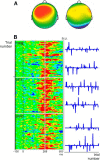A single-trial estimation of the feedback-related negativity and its relation to BOLD responses in a time-estimation task
- PMID: 24553940
- PMCID: PMC6608516
- DOI: 10.1523/JNEUROSCI.3684-13.2014
A single-trial estimation of the feedback-related negativity and its relation to BOLD responses in a time-estimation task
Abstract
An event-related potential (ERP) component reliably associated with feedback processing and well studied in humans is the feedback-related negativity (FRN), which is assumed to indicate activation of midcingulate cortex (MCC) neurons. However, recent approaches have conceptualized this frontocentral ERP component as reflecting at least partially a reward positivity associated with activation in reward-related brain regions, in line with fMRI studies investigating feedback processing in the context of reward evaluation. To discover convergence of electrophysiological and BOLD responses elicited by performance feedback, we concurrently recorded EEG and fMRI during a time-estimation task. The ERP showed relatively more negative amplitudes to negative than to positive feedback. Conventional analyses of fMRI data revealed activation of a number of areas, including ventral striatum, anterior cingulate cortex, and medial prefrontal cortex to positive versus negative feedback. Most importantly, when using single-trial amplitudes of electrophysiological feedback signals to estimate hemodynamic responses, we found feedback-related BOLD-responses in ventral striatum, midcingulate, and midfrontal cortices to positive but not to negative feedback associated with feedback signals in the time range of the FRN. Specifically, activation in these areas increased as amplitudes became more positive. These findings suggest that, in the time-estimation task, a positivity elicited by reward is associated with brain activation in several reward-related brain regions and is driving differential ERP responses in the time range of the FRN.
Keywords: fMRI; feedback-related negativity; reward feedback; single-trial; time-estimation task.
Figures






References
Publication types
MeSH terms
Substances
LinkOut - more resources
Full Text Sources
Other Literature Sources
Medical
